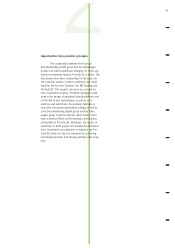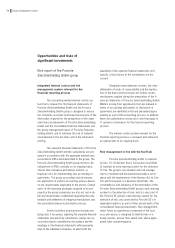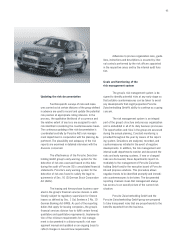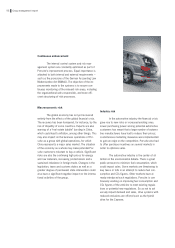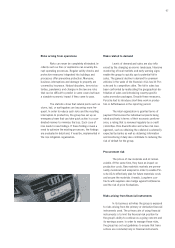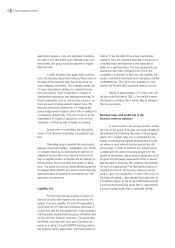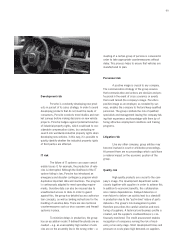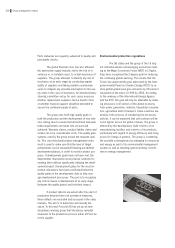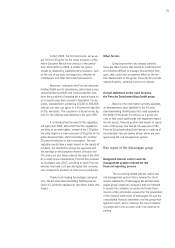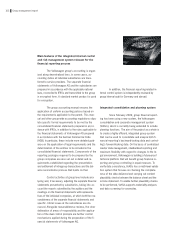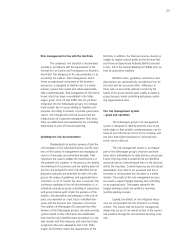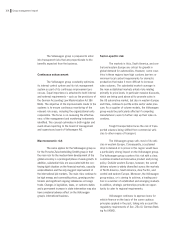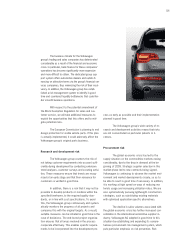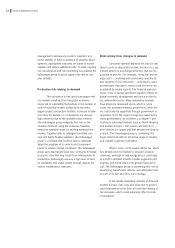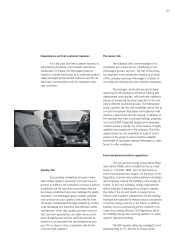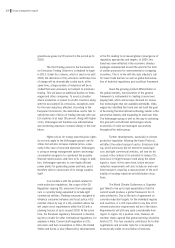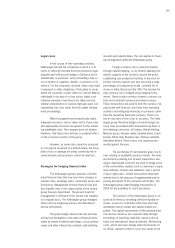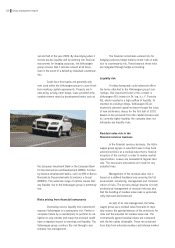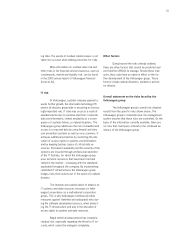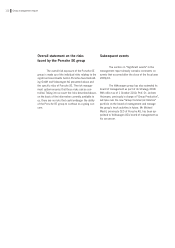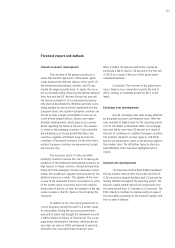Porsche 2009 Annual Report Download - page 103
Download and view the complete annual report
Please find page 103 of the 2009 Porsche annual report below. You can navigate through the pages in the report by either clicking on the pages listed below, or by using the keyword search tool below to find specific information within the annual report.Risk management in line with the KonTraG
The company’s risk situation is documented
annually in accordance with the requirements of the
German Act on Control and Transparency in Business
(KonTraG). The adequacy of this documentation is as-
sessed by the auditors. Risk management, which
forms an operational component of the business
processes, is designed to identify risks in a timely
manner, assess their extent and, where appropriate,
take countermeasures. Risk management at the Scania
brand, which has been consolidated in the Volks-
wagen group since 22 July 2008, has not yet been
integrated into the Volkswagen group’s risk manage-
ment system due to issues relating to Swedish com-
pany law. According to Scania’s corporate governance
report, risk management and risk assessment are
integral parts of corporate management. Risk areas
there are addressed and evaluated by the controlling
department as part of financial reporting.
Updating the risk documentation
Standardized risk position surveys of both the
risk managers of the individual divisions and the mem-
bers of the boards of management and managing di-
rectors of investees are performed annually. Their
responses are used to update the overall picture of
the potential risk situation. In the process, the qualita-
tive likelihood of occurrence and the relative extent of
any loss are assigned to each risk identified and ap-
propriate measures are specified for each risk cate-
gory in the shape of guidelines and organizational in-
structions, so as to counter the risks concerned. The
continuous updating of the risk documentation is co-
ordinated centrally by group controlling in conjunction
with group internal audit. Under the guidance of the
auditors, the plausibility and adequacy of the risk re-
ports are examined on a test basis in detailed inter-
views with the divisions and companies concerned.
The auditors of Volkswagen AG assessed the effec-
tiveness of the Volkswagen group’s risk early warning
system based on this information and established
both that the risks identified were presented in a suit-
able manner and that measures and rules have been
assigned to the risks adequately and in full. Volks-
wagen AG therefore meets the requirements of the
KonTraG. In addition, the financial services division is
subject to regular special audits by the German Fed-
eral Financial Supervisory Authority (BaFin) pursuant
to Sec. 44 of the German Banking Act (KWG) and con-
trols by association auditors.
Workflow rules, guidelines, instructions and
descriptions are systematically recorded and can for
the most part be accessed online. Adherence to
these rules is assured by internal controls by the
heads of the group internal audit, quality assurance,
group treasury, brand controlling and group control-
ling organizational units.
The risk management system
– goals and operation
The Volkswagen group’s risk management
system is designed to identify potential risks at any
early stage so that suitable countermeasures can be
taken to avert the threat of loss to the company, and
any risks that might jeopardize its continued exis-
tence can be ruled out.
The risk management system is an integral
part of the Volkswagen group’s structure and work-
flows and is embedded in its daily business processes.
Events that may entail a potential risk are identified
and assessed on a decentralized basis in the divisions
and at the investees. Countermeasures are introduced
immediately, their effects are assessed and the in-
formation is incorporated into the plans in a timely
manner. The results of this risk management process
are used to support budget planning and controlling
on an ongoing basis. The targets agreed in the
budget planning rounds are verified in revolving
monthly planning reviews.
Equally, the effects of risk mitigation meas-
ures are incorporated into the forecasts in a timely
manner. This means that the board of management
always has access to an overall picture of the current
risk situation through the documented reporting chan-
nels.
103


